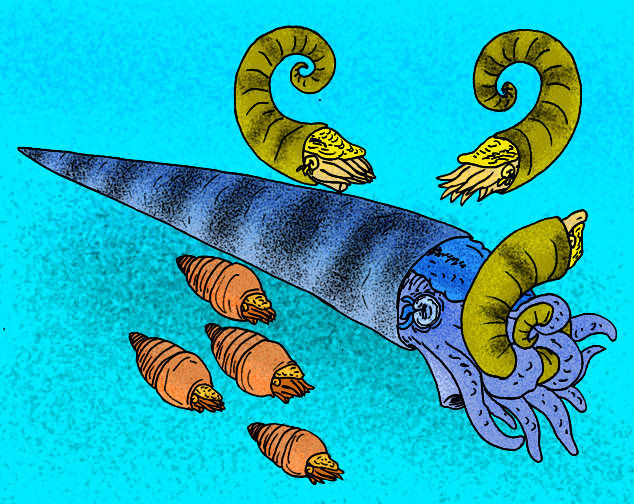|
Foerstellites
''Foerstellites'' is a genus of Ordovician cephalopods from North America, belonging to the family Endoceratidae, in which the siphuncle takes up the entire apex. ''Foestellites'', named by Kobayashi, 1940, is based on the apical part of the conch, or shell, which expands rapidly as septa are added. Not a true nanno type, since the siphuncle is not truly swollen at the apex. Probably the apical end of ''Cameroceras ''Cameroceras'' ("chambered horn") is a genus of extinct, giant orthoconic cephalopod that lived mainly during the Ordovician period. It first appears during the middle Ordovician, around 470 million years ago, and was a fairly common component o ...'' or '' Vaginoceras''. References * Flower, Rousseau H.1958. Some Chazyan and Mohawkian Endoceratida. Jour of Paleontology, V.32, n3, pp433–458, May 1958 * Teichert, C. 1964. Endoceratoidea, Treatise on Invertebrate Paleontology, part K. Geological Society of America and Univ. Kansas Press. Prehistoric nautiloid ... [...More Info...] [...Related Items...] OR: [Wikipedia] [Google] [Baidu] |
Endoceratidae
Endoceratidae is a family of large to very large straight shelled nautiloid cephalopods belonging to the order Endocerida that lived during the Middle and Late Ordovician. They include the largest known Paleozoic invertebrates, represented by '' Endoceras'' and ''Cameroceras''.Teichert C, (1964). Endoceratoidea; Treatise on Invertebrate Paleontology, ''Part K, Mollusca 3''.Flower R. H. (May 1958). "Some Chazyan and Mohawkian Endoceratida", ''Jour Paleo'' 32 (2) pp 433-458 Description Endocerids are characterized by large, generally ventral siphuncles with simple endocones which lack the more complex structures associated with the Proterocameroceratidae and their derivatives. Endocones, nested cone-shaped deposits characteristic of the Endocerida, form in the apical portion of the siphuncle where they balanced the weight of the animal in the body chamber at the opposite end. This helped assure a horizontal orientation while the endoceratid animal was alive. The septal necks are ... [...More Info...] [...Related Items...] OR: [Wikipedia] [Google] [Baidu] |
Ordovician
The Ordovician ( ) is a geologic period and System (geology), system, the second of six periods of the Paleozoic Era (geology), Era. The Ordovician spans 41.6 million years from the end of the Cambrian Period million years ago (Mya) to the start of the Silurian Period Mya. The Ordovician, named after the Celtic Britons, Welsh tribe of the Ordovices, was defined by Charles Lapworth in 1879 to resolve a dispute between followers of Adam Sedgwick and Roderick Murchison, who were placing the same Rock (geology), rock beds in North Wales in the Cambrian and Silurian systems, respectively. Lapworth recognized that the fossil fauna in the disputed Stratum, strata were different from those of either the Cambrian or the Silurian systems, and placed them in a system of their own. The Ordovician received international approval in 1960 (forty years after Lapworth's death), when it was adopted as an official period of the Paleozoic Era by the International Union of Geological Sciences, Intern ... [...More Info...] [...Related Items...] OR: [Wikipedia] [Google] [Baidu] |
Cephalopoda
A cephalopod is any member of the molluscan class Cephalopoda (Greek plural , ; "head-feet") such as a squid, octopus, cuttlefish, or nautilus. These exclusively marine animals are characterized by bilateral body symmetry, a prominent head, and a set of arms or tentacles (muscular hydrostats) modified from the primitive molluscan foot. Fishers sometimes call cephalopods "inkfish", referring to their common ability to squirt ink. The study of cephalopods is a branch of malacology known as teuthology. Cephalopods became dominant during the Ordovician period, represented by primitive nautiloids. The class now contains two, only distantly related, extant subclasses: Coleoidea, which includes octopuses, squid, and cuttlefish; and Nautiloidea, represented by ''Nautilus'' and ''Allonautilus''. In the Coleoidea, the molluscan shell has been internalized or is absent, whereas in the Nautiloidea, the external shell remains. About 800 living species of cephalopods have been identified. Tw ... [...More Info...] [...Related Items...] OR: [Wikipedia] [Google] [Baidu] |
Siphuncle
The siphuncle is a strand of tissue passing longitudinally through the shell of a cephalopod mollusk. Only cephalopods with chambered shells have siphuncles, such as the extinct ammonites and belemnites, and the living nautiluses, cuttlefish, and ''Spirula''. In the case of the cuttlefish, the siphuncle is indistinct and connects all the small chambers of that animal's highly modified shell; in the other cephalopods it is thread-like and passes through small openings in the septa (walls) dividing the camerae (chambers). Some older studies have used the term siphon for the siphuncle, though this naming convention is uncommon in modern studies to prevent confusion with a mollusc organ of the same name. Function The siphuncle is used primarily in emptying water from new chambers as the shell grows. To perform this task, the cephalopod increases the saltiness of the blood in the siphuncle, and the water moves from the more dilute chamber into the blood through osmosis. At the sam ... [...More Info...] [...Related Items...] OR: [Wikipedia] [Google] [Baidu] |
Cameroceras
''Cameroceras'' ("chambered horn") is a genus of extinct, giant orthoconic cephalopod that lived mainly during the Ordovician period. It first appears during the middle Ordovician, around 470 million years ago, and was a fairly common component of the fauna in some places during the period, inhabiting the shallow seas of Laurentia, Baltica and Siberia.Frey, R.C. 1995. U.S. Geological Survey, p.73 Its diversity and abundance became severely reduced following the Ordovician–Silurian extinction events, and the last remnants of the genus went extinct sometime during the Wenlock. In older literature ''Cameroceras'' was treated as the largest nautiloid with shell length about or even , however the large-sized species is no longer belong to genus ''Cameroceras'' but ''Endoceras giganteum'', and the -long specimen is highly doubtful. Description ''Cameroceras'' is a cephalopod, a taxon of molluscs that includes the octopuses, squids and cuttlefish. From comparison with living cephalo ... [...More Info...] [...Related Items...] OR: [Wikipedia] [Google] [Baidu] |

.jpg)
